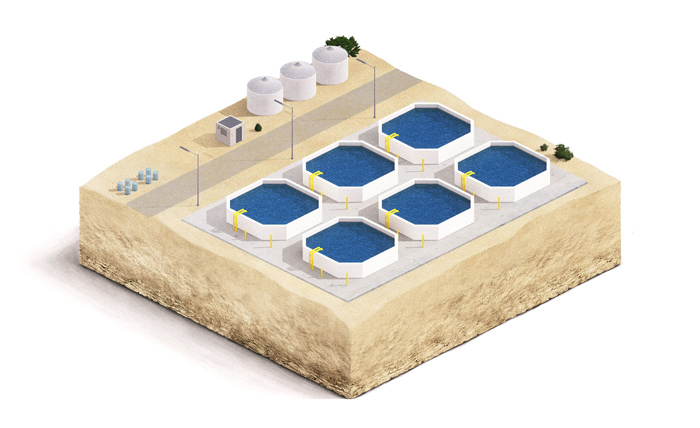
The farming of fish, snails, shrimp, abalone, and other aquatic animals for food can further utilize the seawater infrastructure of the Sahara Forest Project to produce an additional high protein and high-value food. Aquaculture has traditionally been carried out in controlled pens in natural bodies of water. Still, this practice can cause significant environmental disturbances due to unregulated flows of nutrients into the surrounding ecosystem and the escape risk coupled with the risk of transferal of diseases to wild populations. Entirely constructed systems on land do not have this problem and provide better control over the growing environment but suffer from the same geographic and fiscal constraints as algae facilities. These issues can be overcome for marine species by sharing the SFP seawater infrastructure; mariculture, like algae, can be integrated into that infrastructure while ‘using up’ only a tiny fraction of the seawater flow.
The mariculture ponds will be fed with fresh seawater directly from the seawater intake. This is necessary because most marine organisms cannot tolerate the higher salinities found downstream in the SFP system. Fish or shrimp, or other animals are raised in open ponds. As evaporative losses increase the salinity of a pond, the water is cycled out and refreshed with fresh seawater. Upon its removal, the ‘wastewater from the pond is only mildly more saline than seawater – 5–5.5% salt – and is enriched in nutrients thanks to the marine animals’ organic wastes (droppings). In this state, it is ideal for feeding into algae ponds. The system is set up as a simplified ecosystem. Algae can often tolerate mild increases in salinity and thrive on the nutrients in the organic wastes. By the time the water passes through the algae cultivation facility, it will have been naturally purified from all its wastes and ready for use in the greenhouse cooling systems. While providing this service – one that would otherwise have to be carried through costly filtering and purification – the algae use the nutrients they harvest, boosting yields and reducing requirements for the external supply of nutrients. To close the loop, the oil- and nutrient-rich algae can be fed back to the marine organisms, providing a high-performing feed for the farmed animals.
The cultivation of freshwater species, such as Tilapia, may also present significant opportunities to increase the value of the SFP infrastructure. Typical cultivation systems use a recirculating – but not closed – infrastructure that runs on a constant flow of freshwater through the system. Pure freshwater enters the system, and water is enriched with nutrients from the fish waste leaves. The only actual water consumption is through evaporative losses from the cultivation pond, which can be minimized by providing shelter from wind and sun. With such a system engineered to keep evaporative losses low, the irrigation water destined for the external growing areas can easily be used to support freshwater fish cultivation. This allows the valuable freshwater to serve a double purpose; the nutrient-enriched freshwater outflow from the fish farm can be applied directly to irrigate the growing crops without significant filtering or sterilization. This allows a straightforward, low-cost, and low-energy recycling of nutrients from the fish farm while reducing fertilizer requirements in the external planting areas.
As in the marine mariculture systems, the nutrient-rich algae grown at the Sahara Forest Project can be used to feed the fish. In the case of a freshwater aquaculture system, this may prove to be a valuable natural pathway that can transfer nutrients from the salt water-based algae and mariculture systems to the freshwater-based agricultural system.
